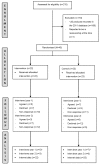Effects of an Advocacy Trial on Food Industry Salt Reduction Efforts-An Interim Process Evaluation
- PMID: 29039802
- PMCID: PMC5691744
- DOI: 10.3390/nu9101128
Effects of an Advocacy Trial on Food Industry Salt Reduction Efforts-An Interim Process Evaluation
Abstract
The decisions made by food companies are a potent factor shaping the nutritional quality of the food supply. A number of non-governmental organizations (NGOs) advocate for corporate action to reduce salt levels in foods, but few data define the effectiveness of advocacy. This present report describes the process evaluation of an advocacy intervention delivered by one Australian NGO directly to food companies to reduce the salt content of processed foods. Food companies were randomly assigned to intervention (n = 22) or control (n = 23) groups. Intervention group companies were exposed to pre-planned and opportunistic communications, and control companies to background activities. Seven pre-defined interim outcome measures provided an indication of the effect of the intervention and were assessed using intention-to-treat analysis. These were supplemented by qualitative data from nine semi-structured interviews. The mean number of public communications supporting healthy food made by intervention companies was 1.5 versus 1.8 for control companies (p = 0.63). Other outcomes, including the mean number of news articles, comments and reports (1.2 vs. 1.4; p = 0.72), a published nutrition policy (23% vs. 44%; p = 0.21), public commitment to the Australian government's Food and Health Dialogue (FHD) (41% vs. 61%; p = 0.24), evidence of a salt reduction plan (23% vs. 30%; p = 0.56), and mean number of communications with the NGO (15 vs. 11; p = 0.28) were also not significantly different. Qualitative data indicated the advocacy trial had little effect. The absence of detectable effects of the advocacy intervention on the interim markers indicates there may be no impact of the NGO advocacy trial on the primary outcome of salt reduction in processed foods.
Keywords: advocacy; food companies; randomized trial; salt reduction.
Conflict of interest statement
The authors declare no conflict of interest.
Figures
Similar articles
-
Protocol for a cluster-randomised trial to determine the effects of advocacy actions on the salt content of processed foods.BMC Public Health. 2016 Jan 25;16:75. doi: 10.1186/s12889-016-2743-4. BMC Public Health. 2016. PMID: 26809561 Free PMC article. Clinical Trial.
-
Unpack the Salt: an evaluation of the Victorian Salt Reduction Partnership's media advocacy activities to highlight the salt content of different foods.Nutr J. 2020 Sep 16;19(1):102. doi: 10.1186/s12937-020-00621-0. Nutr J. 2020. PMID: 32938464 Free PMC article.
-
Drop the Salt! Assessing the impact of a public health advocacy strategy on Australian government policy on salt.Public Health Nutr. 2014 Jan;17(1):212-8. doi: 10.1017/S1368980012004806. Epub 2012 Nov 22. Public Health Nutr. 2014. PMID: 23171657 Free PMC article. Review.
-
Salt reduction in Australia: from advocacy to action.Cardiovasc Diagn Ther. 2015 Jun;5(3):207-18. doi: 10.3978/j.issn.2223-3652.2015.04.02. Cardiovasc Diagn Ther. 2015. PMID: 26090332 Free PMC article.
-
To legislate or not to legislate? A comparison of the UK and South African approaches to the development and implementation of salt reduction programs.Nutrients. 2014 Sep 16;6(9):3672-95. doi: 10.3390/nu6093672. Nutrients. 2014. PMID: 25230210 Free PMC article. Review.
Cited by
-
Changes in sodium levels in Australian packaged foods between 2014 and 2019: an interrupted time series analysis of the impact of the Victorian Salt Reduction Partnership's media advocacy strategy.Int J Behav Nutr Phys Act. 2023 Jun 14;20(1):71. doi: 10.1186/s12966-023-01475-5. Int J Behav Nutr Phys Act. 2023. PMID: 37316889 Free PMC article.
-
A framework of NGO inside and outside strategies in the commercial determinants of health: findings from a narrative review.Global Health. 2023 Oct 10;19(1):74. doi: 10.1186/s12992-023-00978-x. Global Health. 2023. PMID: 37817196 Free PMC article. Review.
References
-
- World Cancer Research Fund International Food Policy Framework for Healthy Diets: Improve Food Supply. [(accessed on 26 September 2014)]; Available online: http://www.wcrf.org/int/policy/nourishing-framework/improve-food-supply.
-
- Trieu K., Neal B., Hawkes C., Dunford E., Campbell N., Rodriguez-Fernandez R., Legetic B., McLaren L., Barberio A., Webster J. Salt reduction initatives around the world—A systematic review of progress towards the global target. PLoS ONE. 2015;10:1–12. doi: 10.1371/journal.pone.0130247. - DOI - PMC - PubMed
-
- Land M.-A., Webster J., Christoforou A., Praveen D., Jeffery P., Chalmers J., Smith W., Woodward M., Barzi F., Nowson C., et al. Salt intake assessed by 24 h urinary sodium excretion in a random and opportunistic sample in Australia. BMJ Open. 2014;4:1–8. doi: 10.1136/bmjopen-2013-003720. - DOI - PMC - PubMed
-
- Keogh J.B., Clifton P.M. Salt intake and health in the Australian population. Med. J. Aust. 2008;189:526. - PubMed
-
- World Health Organization . Guideline: Sodium Intake for Adults and Children. World Health Organization; Geneva, Switzerland: 2012. pp. 1–56. - PubMed
MeSH terms
Substances
LinkOut - more resources
Full Text Sources
Other Literature Sources
Medical


